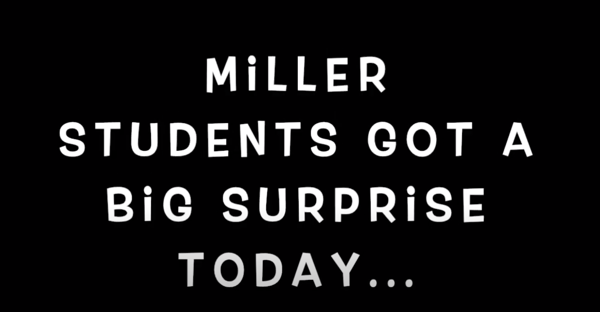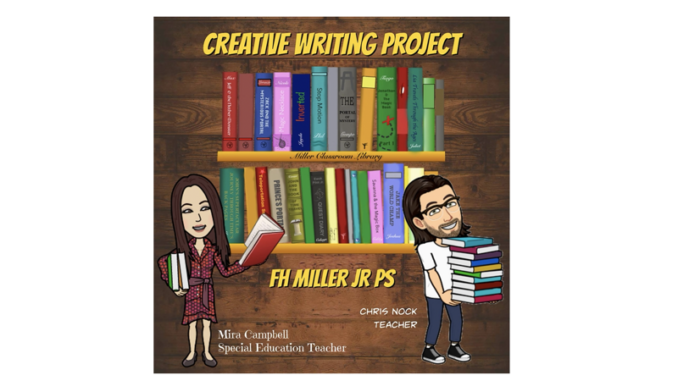
By Mira Campbell & Chris Nock
One of the greatest challenges of a classroom teacher is how to meet the needs of all the students in the classroom, while also engaging and motivating them to achieve their best. Our Grade 4/5/6 Junior classroom at FH Miller is designed through the Toronto District School Board’s (TDSB) inclusive model, supporting all students in one space. Creative writing brings additional challenges because while elementary students are full of imagination, many are often hindered by the mechanics and technical aspects of writing such as spelling and grammar. We wanted to make sure that our writing unit addressed the varied skills, interests and different learning styles in our classroom, allowing all students to read their full potential. My role, as the Special Education teacher, is to work collaboratively with the classroom teacher to support and monitor students with respect to their Individual Education Plans (IEPs). Some students in the class have identified learning disabilities and others are approximately two grade levels behind. I strive to find ways to engage students and regularly use technology. Book Creator’s multimodal tools are a perfect compliment to the Universal Design Framework (UDL) of the classroom. Furthermore, while this project began during in person learning, a large portion was done during remote learning and Book Creator made it easy to pivot. This article documents the teachers and students’ learning journey through a collaborative creative writing unit, entitled “From Plan To Book In Hand”.
Classroom Profile & Lesson Planning:
Having previously worked with the classroom teacher, I knew we worked extremely well together. Chris Nock is our junior classroom teacher. This year, due to Covid-19, we had a small Grades 4/5/6 combined inclusive class with 14 students. The class learning profile includes students with learning disabilities, inattention and socio-emotional challenges. The students enjoy real-life experiences and are proficient with technology. We also knew they would be motivated by having an authentic audience for their stories, by sharing stories on Twitter with the author and a possible feature in Book Creator’s Newsletter.
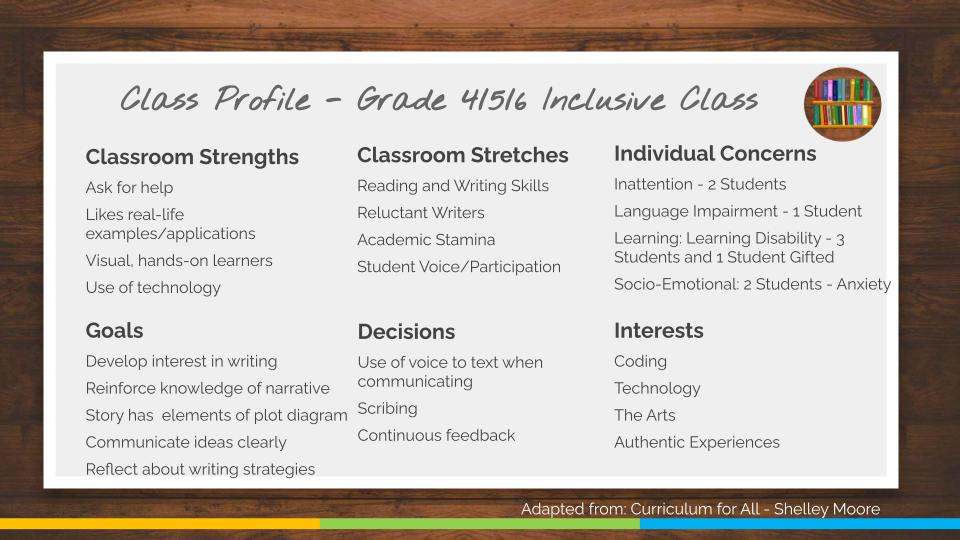
There are several reluctant writers, with limited academic stamina, who require opportunities to learn to communicate effectively. We wanted to build the learning experience around their strengths and interests and motivate the idea of sharing their final stories with a larger audience.
Universal Design Framework
When designing this learning opportunity, we considered the Universal Design for Learning Framework (CAST, N.D.). The three main guidelines to consider are:
- How we stimulate interest/engagement;
- How we present information in different ways;
- How we differentiate the ways students express what they know.
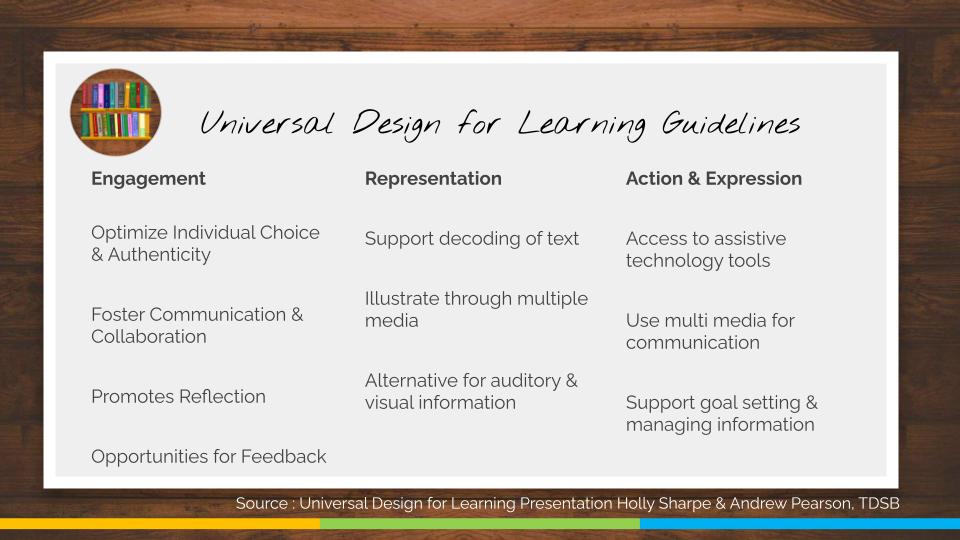
How We Did It:
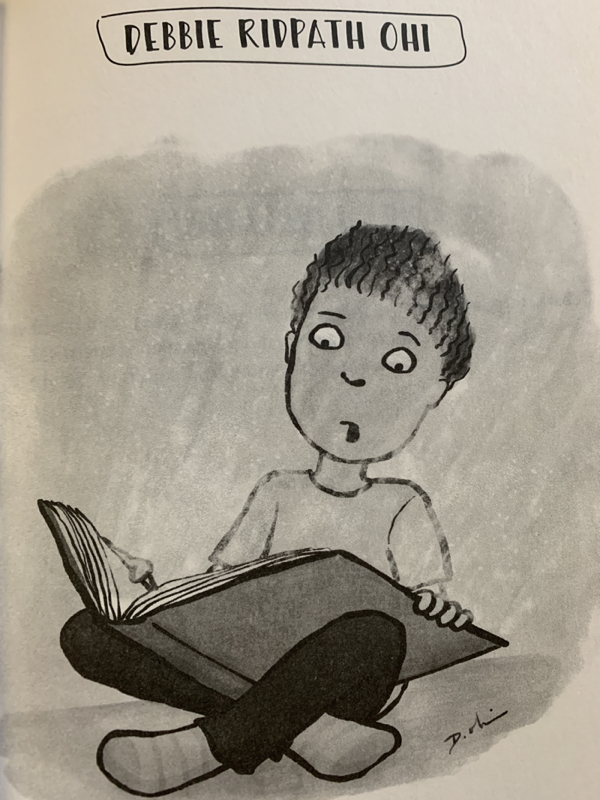
Illustrator Debbie Ridpath Ohi
Inspiration for the Project
We had completed a unit analyzing stories and discussing the elements of a plot diagram. We knew we wanted to do a creative writing unit next and we were looking for a way to support and engage our students. The inspiration for this project came from a drawing prompt by Debbie Ridpath Ohi, featured in Colby Sharp’s Creativity Project. We have collaborated with Debbie in the past and she has always been generous with her time and a source of inspiration for our students.We felt using a drawing as a starting point would spark ideas. We also knew we needed to utilize the technology in our classroom to support & engage our students. All students have access to a Chromebook with Read&Write for Google toolbar which has many features to support writing.
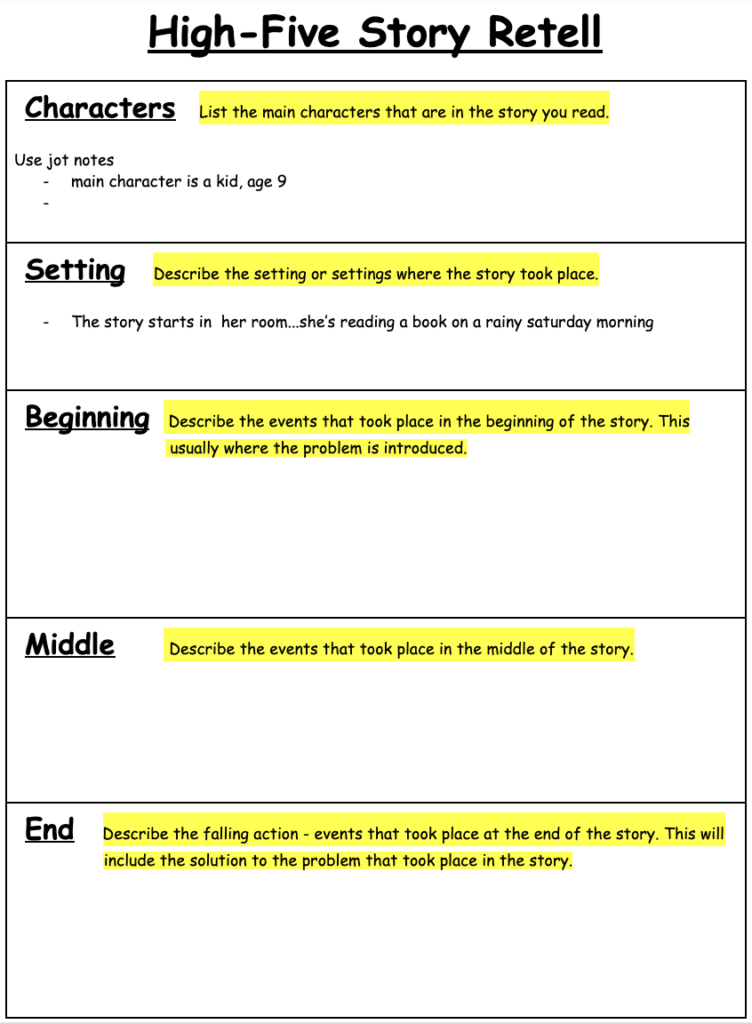
We initially gave our students this graphic organizer with some prompts for each section and they began to write down their ideas. Many started writing their story using full sentences into the chart. Some students were stuck and had trouble generating ideas. We reviewed their work after a couple periods and we realized that our plan had failed.
It was an overwhelming task to start with nothing. The classroom teacher, Chris, and I discussed what we could do. We quickly realized that our students would need significantly more scaffolding. We decided to have a giant class brainstorming session where they could all contribute ideas and we would scribe, allowing them to focus on their imaginative ideas.
This was a huge success.
Students who don’t normally participate or share in front of the whole class, felt comfortable to contribute ideas. We quickly filled in the first few sections, all the way up to the problem. We shared the chart and told students they could choose some of the ideas and were also welcome to change them. This gave them the security of using ideas that we had generated as a class. It was an entry point for many students. Those who were more creative and whose minds were racing with their own ideas, had freedom to go in that direction.
Once they had completed their first draft, we reviewed and discussed what was missing and areas that would require explicit teaching. The classroom teacher gave a mini lesson on descriptive writing where he talked about accessing the five senses and introduced the writing technique, “Show Don’t Tell.” We talked about when to use these techniques and asked students to choose some key moments in the story where they could add them in. That task required higher level thinking to identify and properly implement. Most students required support, while a few were able to successfully add them in independently.
Secondly, we noticed we needed a lesson on internal dialogue and how that functions in a story. It’s a great way to keep the reader interested by sharing how the characters feel and what they are thinking in important story moments.
These lessons were critical to improving their writing skills.
We noticed for several students there was a reluctance to write at the beginning prior to these targeted lessons. This is evident from the student quotes below.
“I didn’t think this project would be so big. I personally didn’t want to do it at first but when I was almost done writing my book I had so many ideas to put in my book and it was hard to pick one and now I really like the project and I actually might want to write a part 2 of my book.”
~ Jayda, Grade 5
“I didn’t like the writing in the beginning but then I started liking it once my story started becoming better. I restarted a couple times, but then I started one story and liked that one and it turned out well. Book creator was fun because you can switch the backgrounds, add sound effects and you can also add drawings and images into it.”
~ Xavier, Grade 5
We made an important decision based around the UDL framework that we needed to meet the students where they were at. For students who were struggling to develop the content of a whole story or having difficulty with some of the writing techniques, we would have them focus on writing only the introduction (up to the story problem). We would make sure that it was well edited and contained descriptive writing and dialogue. Through this, they were able to practise all the writing techniques described above. Essentially, we wanted to reduce the amount of writing, but not sacrifice the content or learning experience.We prioritized a well written, short piece of writing over a long piece missing key expectations. In addition, all our students are comfortable using the Word Prediction and/or the Text to Speech features on the Read&Write for Google Chrome toolbar to get their ideas on paper and remove the barrier of physically writing or typing. These stories are in the book under the section entitled, “Under Construction.” It was also a way to differentiate the expectations for students and still allow them to feel a sense of pride in their end product.
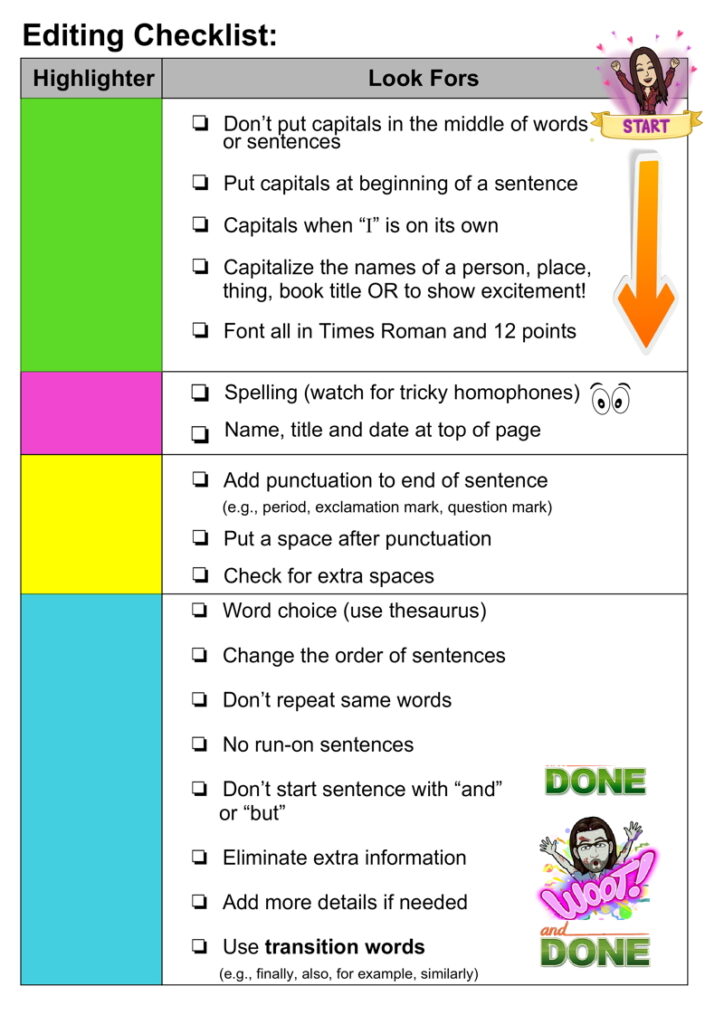
For the editing phase, students all had individual copies of a colour coded checklist. We structured it with basic editing at the top and it built to more complex editing (e.g., word choice, transition words, eliminate extra information, etc.) We had used this previously for other assignments.
Students spent a long time revising their stories.
Many students were surprised that the editing and revising phase can be longer and more essential than the initial phase (first draft). That realization is very important because many students think that writing is mainly the first draft or initial stage. We spent a lot of time in the editing phase to try and work against this ingrained notion. However, it was amazing to see that some already had these good instincts.
“I already wanted to become a writer and I knew that you couldn’t write a first draft and say, ‘Done!’”
~ Imi, Grade 4
“I knew writing took a lot of work, but I thought it was different for professional writers because they have written more stories. I thought it was easy for them to write.”
~ Xavier, Grade 5
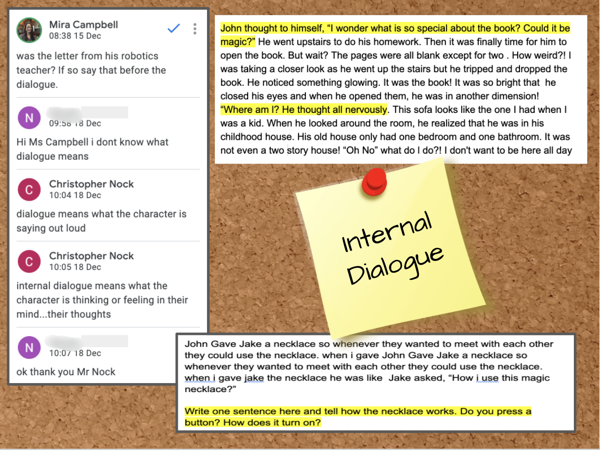
More examples of descriptive feedback.
Transition to Remote Learning
Around this time, we also transitioned to remote learning. This was a fairly seamless process and in fact, I think it allowed the students to be more focused. We had many teacher and student conferences reading their work out loud and asking them questions via Zoom. We also left feedback in the Google Docs for them to work on while they waited to conference with us.
Import Stories into Book Creator
The next step was to import the text into Book Creator. You can easily copy and paste from Google Docs into Book Creator. For some students we did that for them to speed up the process. We told students in advance that they should use a large font and add a small amount of text to each page. That allowed for images to be added. We also reminded them not to put any text or image too close to the edges so that it would not get cut off if we decided to print them later.
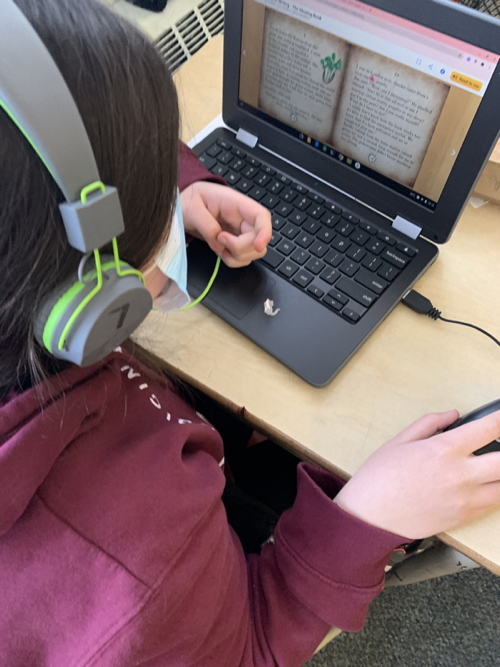
Collaboration to get ideas
when stuck.
Book Creator Features
Our goal was to design an experience where all students could be successful with creative writing and where we accounted for different learning styles. Book Creator provides built-in support for all learners. Students can choose to use Voice to Text, make an audio recording of their story or type it in directly. They can also use the Read to Me feature to listen to their writing and check for mistakes. One of the most amazing features is that you have the ability to work collaboratively in the same book (this is a premium feature). The Real-Time Collaboration feature allowed us to remotely give feedback, check in on their progress and to support the students if they had questions. Both teachers and students used the yellow square shape to make “sticky notes” for comments or questions. In addition, all students are part of the same Book Creator Classroom Library which allows them to view, but not edit each other’s books as they were writing them.

for Chrome Read to Me Feature.
“I like how you can see other people’s books and learn from other people’s books.”
~ Juliet, Grade 5
One Grade 4 student dictated his whole story, which removed the obstacles of physically writing and getting stuck on technical aspects. It allowed him to focus on being creative. He also used the recording feature as a way to remember ideas for his story.
Adding images, graphics, drawings & more!
This part of the project is where students’ creativity and stories come to life! They all started with a blank white page. It was amazing to see how unique each of their stories and page layouts were.
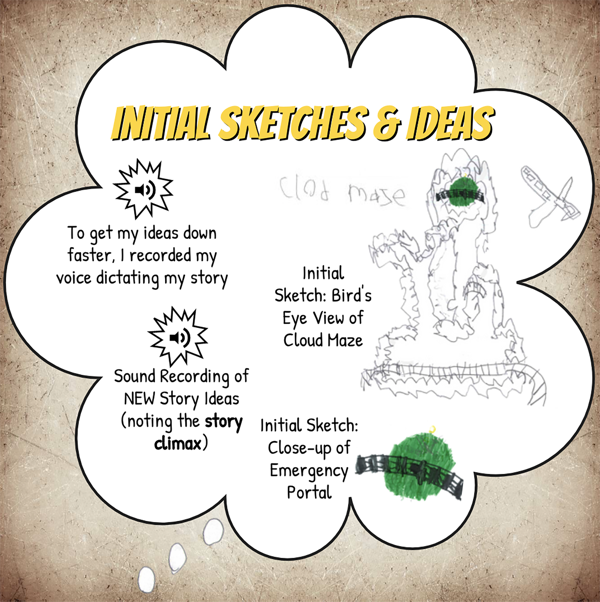
and narrates the initial version of the story.
Book Creator has a built-in safe search for images that come from Pixabay.com (which is a website of royalty-free images). Students used a mixture of clipart art from Google (under the Creative Commons License), their own drawings and images from Pixabay. We helped students simplify some of their layouts and reminded them that the priority was to be able to easily read the text.

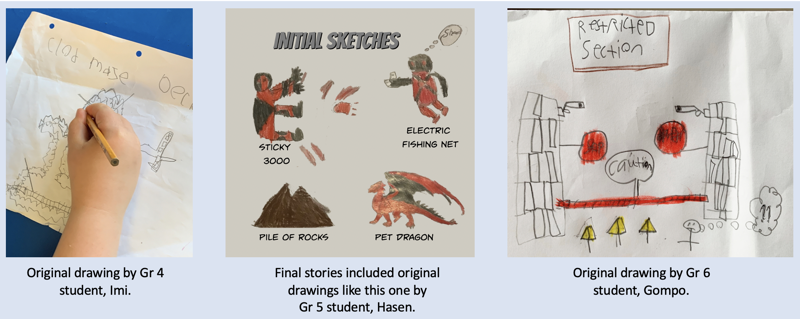
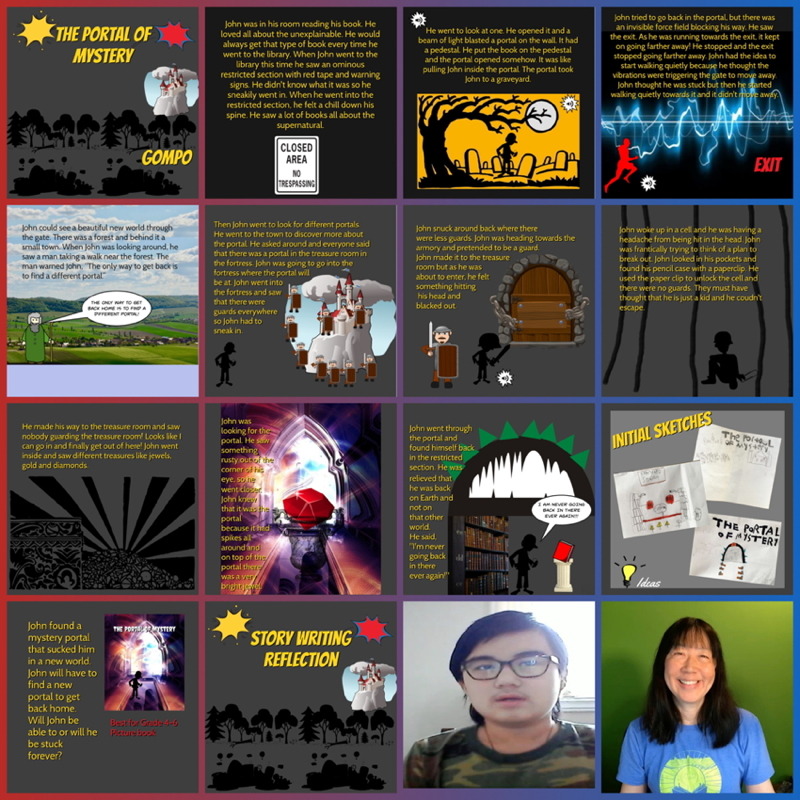
Author/illustrator Debbie Ridpath Ohi (bottom right) is impressed!
Class Book
We knew that with such an ambitious project, there was a possibility that not all students would finish their books. We took our time with the creation process so it was unhurried, but having a cut-off point was necessary. Interestingly, no-one felt that they hadn’t finished, they were all equally proud of what they had produced. I think it’s important to have differentiation of expectation, to meet the needs of the learner. As previously mentioned, we honoured these stories in a section labeled “Under Construction” and they were included in our class book. We then combined all the stories into one giant class book which is very easy to do in Book Creator.
Final Celebration
Our final celebration (or so we thought) was arranging an online class reading of their stories over Zoom. We invited our two principals to join. They were thoroughly impressed with the students and Principal Heather Wheeler insisted that we print actual copies of all the books! This can be a time consuming process, but the results are well worth it! For more information, see the instructions below.
Printing Process: Step-by-Step Instructions for Printing Book Creator Books
Video Tutorial on how to Print
Extending Student Learning to the FH Miller Community & Beyond
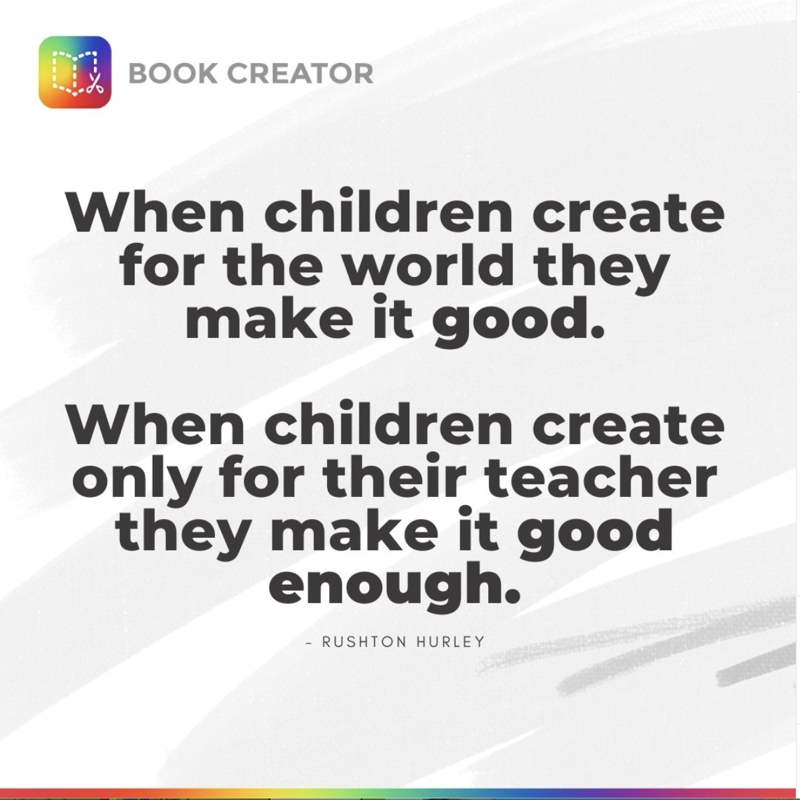
We shared the combined class book on Twitter and tagged author Debbie Ridpath Ohi. The students knew from the start of the project that we would be doing this. Having an authentic audience motivates students to do their best work. It also gives a real purpose so that it’s not just a school assignment. Instead of handing in their writing to the teachers, they were handing their books to their peers and beyond.
A classroom community of learners can be very powerful. It’s more authentic when they learn from each other versus being told by the teacher. Furthermore, by sharing online, their class book is readily accessible and available to read online anytime for the foreseeable future. It doesn’t just go inside their desks collecting dust.
Connect with Author & Illustrator Debbie Ridpath Ohi: Debbie retweeted our project and did a virtual visit with our students. This is something any class can do! For more information about Debbie’s virtual meets, visit her website.
Flipgrid Reflections
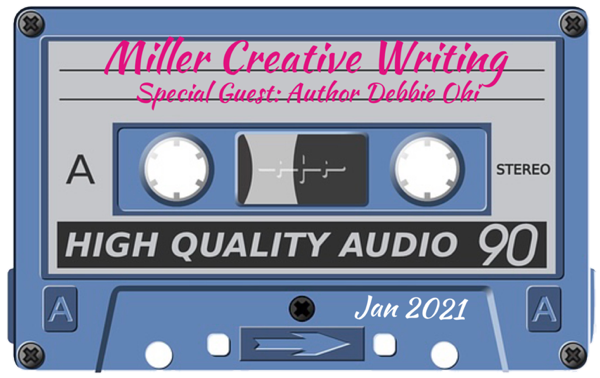
and questions for the author.
When the author told us she uses Flipgrid video to connect with students, we decided to use this opportunity to have them reflect on their writing. Students recorded their reflections on the book creation process – what they learned, what strategies they employed for writing, and a question for Debbie. She will send a personalized pre-recorded video back to students. We embedded these to the end of the class book in Book Creator.
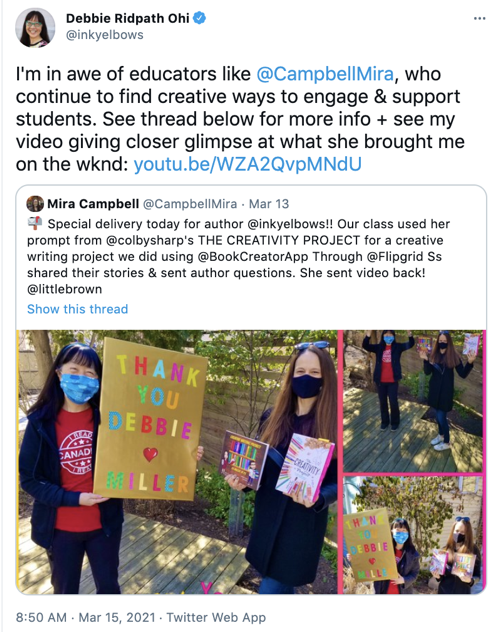
Ridpath Ohi! Read the thread on Twitter.
What was powerful for students is that Debbie gave feedback on their books and answered their questions – reinforcing what they’d been taught (“Yes, professional authors also have to brainstorm with a graphic organizer!”). She told them that she reads her writing out loud to catch mistakes, does many revisions to her writing and sometimes spends a whole year working on one book. It was incredibly empowering for the students to have someone validate their work in this way.
“Listening to someone read my story helps me catch the mistakes I can’t catch reading on my own.”
~ Tiago, Grade 4
“I find that listening to my story helps me by knowing if the story makes sense. For example, let’s say it’s a run-on sentence. If I read it over then I’ll say, ‘oh there needs to be a period here or a comma here’ and that’s how it helps me.”
~ Xavier, Grade 5
Grand Finale – Big Reveal!
So after making the decision to print the books, the grand finale to the project came when we were able to present the printed books to each student, in person. This was a total surprise. Watch the video below to see how it went! (Be prepared for goosebumps!).
Zoom with Dan Kemp From Book Creator
Book Creator featured this project in their April newsletter. We were deeply honoured and our students were really excited!
The students asked if they could meet with Dan from Book Creator over Zoom. We realized this would be a great opportunity for them to meet & interact with an expert in the field. The students generated many insightful questions. It was a fantastic experience.

So what are the benefits of collaboration? A Classroom Teacher’s Perspective:
What an amazing teaching experience to work so closely with a Special Education teacher on a writing unit. To start with, simply having an extra pair of hands meant that as our class conversation was happening with one teacher leading the oral component, the other was documenting student ideas to be shared immediately following the discussion. This timeliness, the quick feedback and curated comments continued throughout the unit, facilitated by two teachers not working in separate roles, Classroom and Special Education, but together as part of a bigger whole.
Oral feedback could be instantly documented and sent to the students. Another exciting aspect was the ability to specialize based upon the skill set of each teacher; one of us could lead using our expert knowledge of dialogue and descriptive writing, at other times the other teacher would lead, using their expert skills and knowledge in technology; truly two teacher heads are better than one. It was also amazing to, at any point, have a teacher that could oversee the class in general and attend to the more common and basic questions of the whole, while little guided groups happened in break out rooms where the other teacher could address issues that required more attention and intervention. This ability to double the instructional time meant that differentiation was much more precise, effective and tailored to each student’s need, truly based on diagnostic and ongoing formative assessment.
Reflecting on the Experience:
Professional Growth as a Teacher
Ideology – Asset Versus Deficit Based Approach – we need to have the same approach we use with students with our colleagues and administrators. They may not have the same skill set, but understanding that they have something equally valuable to share and the combination of both can produce far greater results.
A meaningful learning experience that encourages professional growth – both partners bring similar and different experiences and expertise to the task. Throughout the collaboration process, you may find that your partner is stronger in one area than you. For example, the Special Education Teacher (Mira) is very skilled with technology, while the classroom teacher (Chris) is skilled at teaching writing techniques. We learned a lot from each other as we addressed the different needs of our students as well as modelling a growth mindset as we learn new skills from our colleague.
Collaborating with a teacher-librarian – due to Covid-19, all school libraries in the TDSB were closed. However, I was still able to utilize my background experience as a teacher-librarian (TL) in this new classroom role. As a TL, I have extensive experience collaborating with teachers. I regularly co-plan and co-teach students from Kindergarten to Grade 6 on a variety of topics. Chris and I have successfully worked together for many years in the library learning commons (LLC) on Book Skits, as well a variety of other projects. For this creative writing unit, I was able to draw on my knowledge of resource materials, share my technology expertise and connect students with author Debbie Ridpath Ohi which all enriched the learning experience. I found students also needed guidance to use proper sources for images and to correctly cite media they used in their stories. Students have come to know our library at Miller as a creative place where they collaborate and explore technology (e.g., green screen, robots, iPads, etc.) and, of course, do many Book Creator projects. This creative writing project was a natural extension of the learning that happens in our LLC in a typical year.
Support from someone who wants to help you achieve your common goal – there
is a great deal of trust involved when co-teaching. You have to feel safe enough with the other person to willingly take risks and share your ideas. Also, the task is achieved more efficiently with two people, as opposed to one, and large projects become less overwhelming.
Opportunity to model an important learning skill for students – Collaboration. The interaction between teachers becomes part of the learning experience. Furthermore, as colleagues collaborating, we challenge each other. That promotes rich dialogue and ultimately, we achieve more.
It’s more fun working with a colleague – the excitement and enthusiasm for a
project builds when we work together. The students see our excitement and it transfers to them.
How to Achieve Successful Student Results
It’s a good idea to start with a class brainstorm – Thinking of teaching the whole child, many students have anxiety about starting a big writing project with a blank page staring back at them (…many adults do too!). Making the brainstorm a whole class activity builds excitement and helps students who have difficulty generating ideas. The students built off each other’s ideas. It was a safe way to share and not have to worry about the mechanics of writing because the teacher was writing all the ideas down. We shared the class brainstorm immediately after as a resource.
We came to this realization after an initial period of writing where we noticed many writers in our class were struggling to get started. It was a great way to scaffold the idea generation process.
Let It Go
Sometimes as teachers, we get attached to our plan and how we imagine lessons will go. Being able to stop, adjust our plans and ideas to meet the students where they’re at is the art of moving forward by stepping back, even if it doesn’t feel like it.
It’s critical to provide students with choice and a variety of ways to share their voice – Book Creator provided the flexibility to express their individual creativity and style. The unexpected outcome of this project was how engaged the students became in the writing experience and how they worked on this project for an extended period of time. Students who were reluctant writers or who rarely participated in class were able to shine. Deep learning was evident because it was a meaningful experience with an authentic audience.
Technology is an invaluable tool – that supports a diverse range of abilities and ensures their success. Students were willing to take risks and try new things when they felt supported by their teachers and when they had access to the right tools. All students had access to a chromebook to write their stories. They used Google Docs and the Read&Write for Google Chrome for their initial draft and Book Creator’s built-in tools for the final version which both helped to support their writing.
Differentiating the expectations is necessary – the “Under Construction:” section is a great way to make sure all students are included in the class book, even if they do not write a complete story. We wanted students to showcase their best writing that incorporated our lessons and for some, that meant they only wrote the beginning
Students need specific lessons on writing techniques – such as, “Show, Don’t Tell” and how to include internal dialogue as well as editing. Another prerequisite of this project was our narrative unit where we studied many different narratives. We also broke down a narrative plot diagram and were looking for students to incorporate those elements
Having a global audience outside of their classroom, shows students that their work is valued. It was meaningful when we shared their stories on Twitter, were featured in Book Creator’s Newsletter and had a Zoom chat with Dan Kemp from the Book Creator team. Our students thrived on these authentic experiences and they made the project unforgettable.
We hope you learn from our experience and embark on a collaborative journey of your own. Consider what can be achieved beyond the curriculum and traditional classroom lessons.
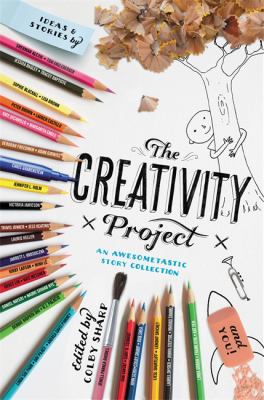
Resources:
More Information on Book Creator
The Creativity Project: An Awesometastic Story Collection, by Colby Sharp (Little Brown, 2018). This book is an excellent resource for writing. It has a collection of story starters from many well-known children’s authors.
Read&Write for Google Chrome (Texthelp)

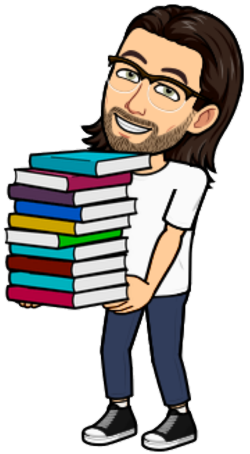
Mira Campbell has more than 14 years experience as an educator. She is currently the Special Education Teacher & the Elementary Chair at FH Miller Jr. PS, having been reassigned from her role as the school’s teacher-librarian as part of pandemic staffing contingencies. Mira is also a Digital Lead Learner Mentor with the Toronto District School Board (TDSB) and a Book Creator Ambassador. Follow Mira on Twitter @CampbellMira
Chris Nock is a dedicated and experienced educator with more than 13 years of teaching experience with the TDSB. He currently teaches Grade 4/5/6 classroom at FH Miller Jr. PS.
